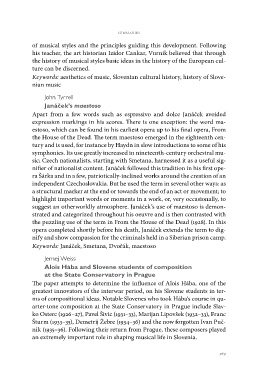Page 371 - Weiss, Jernej, ur. 2018. Nova glasba v “novi” Evropi med obema svetovnima vojnama ?? New Music in the “New” Europe Between the Two World Wars. Koper/Ljubljana: Založba Univerze na Primorskem in Festival Ljubljana. Studia musicologica Labacensia, 2
P. 371
summaries
of musical styles and the principles guiding this development. Following
his teacher, the art historian Izidor Cankar, Vurnik believed that through
the history of musical styles basic ideas in the history of the European cul-
ture can be discerned.
Keywords: aesthetics of music, Slovenian cultural history, history of Slove-
nian music
John Tyrrell
Janáček’s maestoso
Apart from a few words such as espressivo and dolce Janáček avoided
expression markings in his scores. There is one exception: the word ma-
estoso, which can be found in his earliest opera up to his final opera, From
the House of the Dead. The term maestoso emerged in the eighteenth cen-
tury and is used, for instance by Haydn in slow introductions to some of his
symphonies. Its use greatly increased in nineteenth-century orchestral mu-
sic; Czech nationalists, starting with Smetana, harnessed it as a useful sig-
nifier of nationalist content. Janáček followed this tradition in his first ope-
ra Šárka and in a few, patriotically-inclined works around the creation of an
independent Czechoslovakia. But he used the term in several other ways: as
a structural marker at the end or towards the end of an act or movement; to
highlight important words or moments in a work, or, very occasionally, to
suggest an otherworldly atmosphere. Janáček’s use of maestoso is demon-
strated and categorized throughout his oeuvre and is then contrasted with
the puzzling use of the term in From the House of the Dead (1928). In this
opera completed shortly before his death, Janáček extends the term to dig-
nify and show compassion for the criminals held in a Siberian prison camp.
Keywords: Janáček, Smetana, Dvořák, maestoso
Jernej Weiss
Alois Hába and Slovene students of composition
at the State Conservatory in Prague
The paper attempts to determine the influence of Alois Hába, one of the
greatest innovators of the interwar period, on his Slovene students in ter-
ms of compositional ideas. Notable Slovenes who took Hába‘s course in qu-
arter-tone composition at the State Conservatory in Prague include Slav-
ko Osterc (1926–27), Pavel Šivic (1931–33), Marijan Lipovšek (1932–33), Franc
Šturm (1933–35), Demetrij Žebre (1934–36) and the now forgotten Ivan Puč-
nik (1935–36). Following their return from Prague, these composers played
an extremely important role in shaping musical life in Slovenia.
369
of musical styles and the principles guiding this development. Following
his teacher, the art historian Izidor Cankar, Vurnik believed that through
the history of musical styles basic ideas in the history of the European cul-
ture can be discerned.
Keywords: aesthetics of music, Slovenian cultural history, history of Slove-
nian music
John Tyrrell
Janáček’s maestoso
Apart from a few words such as espressivo and dolce Janáček avoided
expression markings in his scores. There is one exception: the word ma-
estoso, which can be found in his earliest opera up to his final opera, From
the House of the Dead. The term maestoso emerged in the eighteenth cen-
tury and is used, for instance by Haydn in slow introductions to some of his
symphonies. Its use greatly increased in nineteenth-century orchestral mu-
sic; Czech nationalists, starting with Smetana, harnessed it as a useful sig-
nifier of nationalist content. Janáček followed this tradition in his first ope-
ra Šárka and in a few, patriotically-inclined works around the creation of an
independent Czechoslovakia. But he used the term in several other ways: as
a structural marker at the end or towards the end of an act or movement; to
highlight important words or moments in a work, or, very occasionally, to
suggest an otherworldly atmosphere. Janáček’s use of maestoso is demon-
strated and categorized throughout his oeuvre and is then contrasted with
the puzzling use of the term in From the House of the Dead (1928). In this
opera completed shortly before his death, Janáček extends the term to dig-
nify and show compassion for the criminals held in a Siberian prison camp.
Keywords: Janáček, Smetana, Dvořák, maestoso
Jernej Weiss
Alois Hába and Slovene students of composition
at the State Conservatory in Prague
The paper attempts to determine the influence of Alois Hába, one of the
greatest innovators of the interwar period, on his Slovene students in ter-
ms of compositional ideas. Notable Slovenes who took Hába‘s course in qu-
arter-tone composition at the State Conservatory in Prague include Slav-
ko Osterc (1926–27), Pavel Šivic (1931–33), Marijan Lipovšek (1932–33), Franc
Šturm (1933–35), Demetrij Žebre (1934–36) and the now forgotten Ivan Puč-
nik (1935–36). Following their return from Prague, these composers played
an extremely important role in shaping musical life in Slovenia.
369


